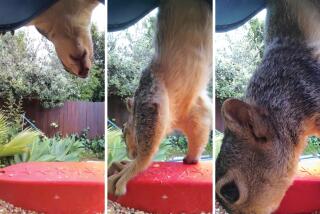Rat Patrol
SANTA ANA â Architects worry about the design of new buildings and residential developments. Building inspectors make sure they comply with government codes. Landscape architects work to make them more appealing to the eye.
Gary Reynolds is more concerned about whether rats can hide in the palms, or mosquitoes will breed in the fake streams or artificial lakes.
Reynolds and the other ecologists at the Orange County Vector Control District scrutinize dozens of development plans every year, searching for ways to make the planned projects less inviting to unwanted insects and rodents.
The agency has been providing the service to city planning departments and developers for more than a decade. But officials said theyâve noticed an increasing number of requests for help in the last few years.
With a new development boom underway in Orange County, they expect to remain busy next year as well.
In the last two years, Reynolds and his team have reviewed plans for projects in the Irvine Spectrum, Newport Coast and Mission Viejo, as well as Coto de Caza and Rancho Santa Margarita.
Reynolds said he pays special attention to the proposed ground cover and ornamentals. He urges landscape architects to avoid plants such as Algerian ivy, yucca and bougainvillea--which rats and mice favor for nesting--in favor of less dense plantings with fewer hiding spaces.
If an landscape architect requires a row of palms for that Mediterranean feel, Reynolds and his team suggest ways to keep the field mice away.
Palm trees have proven far too popular to ban--even though Jim Webb, a forensic entomologist for the agency, described them as ânotorious harborers of rats.â So officials suggest that developers trim the palms regularly and install small metal ârat guardsâ that prevent rodents from climbing into the trees and setting up house amid the fronds.
Vector control also cautions developers who insist on that babbling brook and shimmering lake as the center of their condo complex or golf course.
If a development calls for a rustic artificial creek, the agency looks for ways to prevent mosquitoes from using the waterway as a breeding ground and nearby residents as a source for their evening meals.
Because water attracts mosquitoes, Reynolds suggests that builders stock the lakes with Gambusia affinis, a tiny fish that swims around eating the insectsâ larvae. Some species of water beetles will also kill the larva.
âIf we can take care of a problem before a building goes up, it reduces the number of service calls we will have to make in future years,â he added.
Making new office parks and condo complexes safe from biting insects and disease-bearing rats can be a challenge, given that indoor streams, ivy-covered hills and other aesthetic amenities that attract the vermin are popular staples of suburban architecture.
Officials said their efforts are especially important for developments on the fringes of farmland, undeveloped prairie and wilderness preserves, where nature and development are most likely to clash.
The vector control district has dealt with several cases over the last few years involving rodents from rural areas who carry such potentially deadly diseases as hantavirus and the bubonic plague. St. Louis encephalitis can be transmitted to humans from mosquitoes.
âLooking at this in the planning stage is taking a proactive stance on a public health issue,â said Webb. âBen Franklin was right: An ounce of prevention is worth a pound of cure.â
The concept of reviewing environmental impact reports and other planning documents with an eye on vermin control first emerged in the mid-1970s. In Orange County, the practice grew slowly over the last dozen years, with cities such as Irvine, Costa Mesa and Santa Ana having the vector control agency check some plans.
âThey do a good job for us,â said Bob Strocheim, Irvineâs building safety manager.
Vector officials said more cities have requested service in recent years, a trend they attribute in part to increased development in hills, canyons and around nature preserves, where insect and rodent intrusion is most common.
Gil Challet, general manager of the vector control district, also credits members of the vector control board for encouraging city planners to seek the agencyâs help. âPeople are more aware of what we do now,â he said. âI think people are seeing the impact we can have.â
Beyond the designs of the buildings, vector officials also suggest construction methods that will keep vermin away. The grading of coastal chaparral, for example, forces field mice who live in the grasslands to scatter into nearby housing developments.
âWe had a case like that in Turtle Rock about 10 years ago,â Reynolds said. âThere was grading going on, and mice had nowhere to go. People who lived nearby reported trapping them on garbage day in their trash cans.â
(BEGIN TEXT OF INFOBOX / INFOGRAPHIC)
Rodent Reduction
While builders can choose what they plant to reduce mice and rat infestations in new housing developments, most people already have established yards. This means taking three basic steps to keep rodents at bay: Seal tiny entrances rodents use to enter the house, remove food sources and get rid of both inside and outside nesting areas. Prevention and removal tips:
RATS
Rats can crawl through an opening as small as half an inch, but prefer to stay outside unless weather becomes cold or wet.
Health concern: Food contamination; chew electrical wiring and plumbing hoses
Nesting areas:
Bougainvillea
Ivy
Palm trees
Yucca trees
Attic insulation
Under sinks
Behind refrigerators
****
MICE
Mice can squeeze through an opening as small as a quarter of an inch. They have minimum food requirements and prefer to stay within 15 feet of a food source.
Health concern: Hantavirus
Nesting areas:
Sheds
Garage
Ivy
Ice plants
Acacia
Cardboard boxes
Piles of rags
****
MAINTENANCE
Tips for reducing rodent habitat and limiting their food supply:
* Trim limbs away from roof line or home
* Thin heavy vegetation, especially along fences
* Pick fruit from trees and ground; gather vegetables from garden daily
* Screen windows to attics
* Seal small cracks, gaps leading into attic
* Caulk around where air-conditioning ducts and vents enter home
* Seal housing around pool or spa heaters or pumps
* Use metal trash cans; keep lids on them
* Store pet food in metal containers; rats can gnaw through plastic
****
SIGNS OF INFESTATION
* Chewed washing or dryer hoses
* Cotton stuffing pulled from furniture
* Shredded paper, cardboard; chewed plastic cans
* Droppings in or near food sources
* Piles of empty snail shells (rats eat snails)
****
TRAPPING TIPS
Traps are the preferred method of eradication since poison allows rodents to find hiding places inside the house before dying. Some suggestions:
* Mice can be easily trapped since theyâre naturally curious and will investigate the trap
* Rats are suspicious; bait unset traps with peanut butter for two or three nights before actually setting trap
* If you use poison, place bait inside a cardboard box to prevent it being dragged to area where children or pets may accidentally eat it
****
WHO TO CALL
For more information, or to make an appointment for a Vector Control technician to check your property, call (714) 971-2421.
Sources: Orange County Vector Control and Times reports
Researched by APRIL JACKSON / Los Angeles Times
More to Read
Sign up for Essential California
The most important California stories and recommendations in your inbox every morning.
You may occasionally receive promotional content from the Los Angeles Times.











